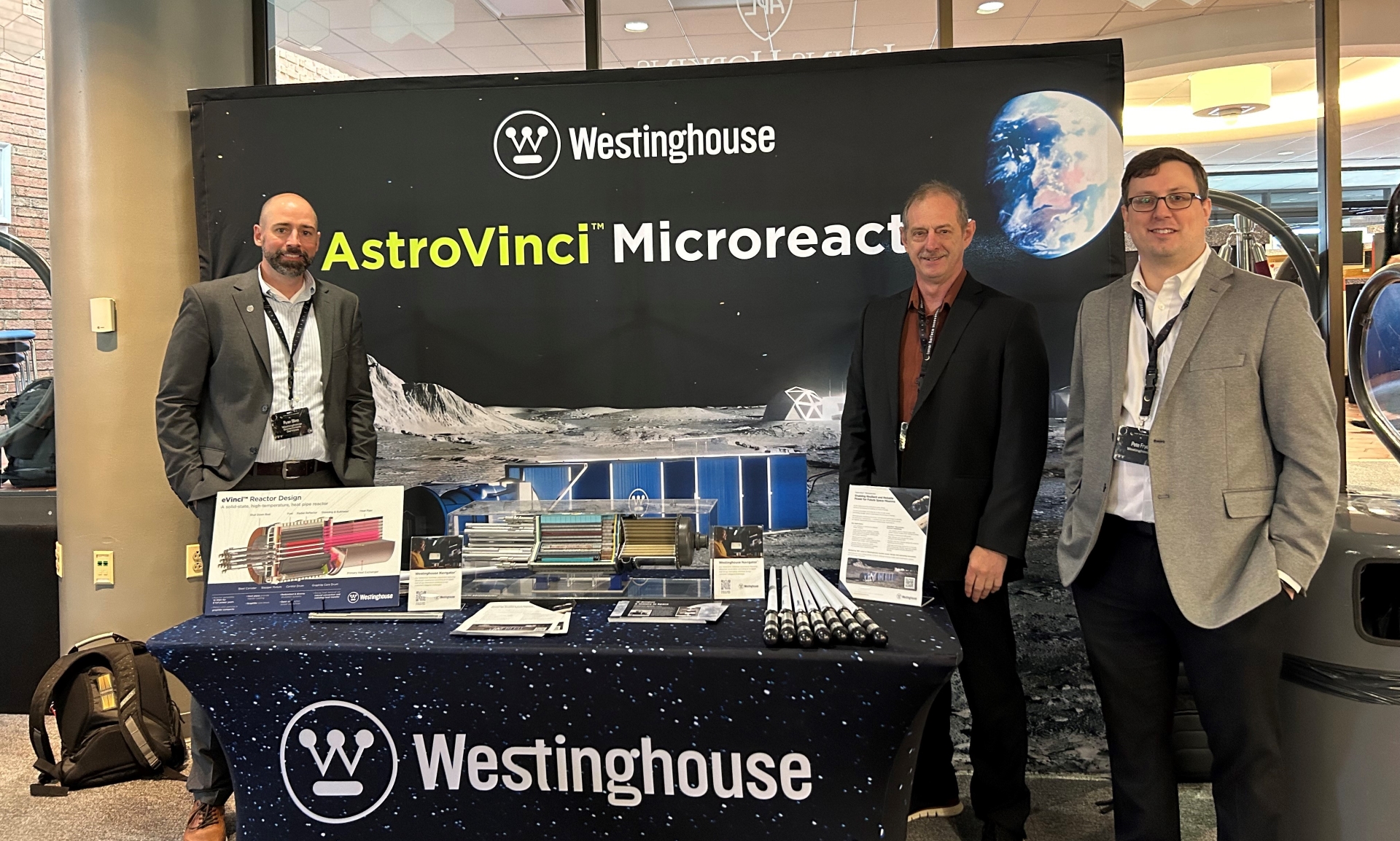Over six decades ago, Westinghouse supplied the world’s first commercial reactor. Today, Westinghouse supplies roughly half of the nuclear power reactors operating around the globe. Now, we are venturing to take nuclear to the Moon and the great beyond.
Leveraging the eVinci™ microreactor technology, Westinghouse is developing the AstroVinci™ microreactor capable of supporting various mission types and addressing the power needs for Satellite and Lunar surface applications.
Lunar Surface Innovation Consortium
As part of the AstroVinci launch, our team exhibited and spoke at this year’s annual Lunar Surface Innovation Consortium in Maryland. Our team of space innovators was on site at our AstroVinci booth and spoke on a technology showcase panel to discuss our microreactor capabilities and applications with potential partners and customers.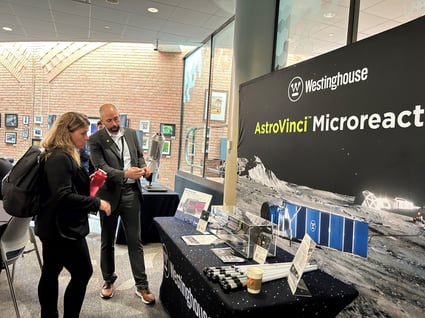
“This opportunity allowed us to connect with stakeholders in academia, NASA and the space industry dedicated to the development of a sustained presence and exploration of the lunar surface,” said Krish Pandya, Westinghouse Strategy Officer for Fission Surface Power.
Throughout the week, our AstroVinci team met with key leaders in the space sector, allowing our team the opportunity to discuss with potential stakeholders about how our technology meets space exploration requirements. Ranging from lunar surface operations, infrastructure builds, transportation and more, we networked and addressed how the AstroVinci can aid U.S. capabilities in the macro space market.
“Westinghouse’s participation in LSIC allows us to directly coordinate with end users of a power grid on the Moon. It’s great that our team gets to coordinate directly with end users who have large upcoming demands for power and heat generation,” said Ryan Blinn, Director of Westinghouse Space and Energy Systems. “This allows Westinghouse to position AstroVinci as the primary solution to power Artemis basecamp and In-Situ Resource Utilization (ISRU), such as hydrogen and oxygen production, mining and scientific experiments.”
Panel Technology Showcase
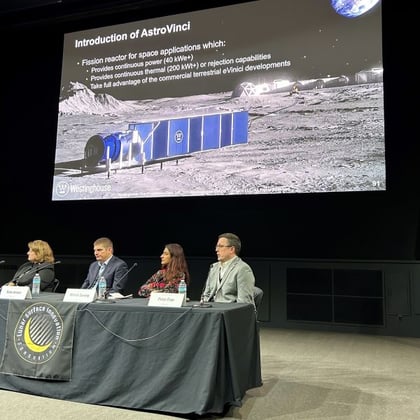 On Wednesday, our team was able to partake in the technology showcase. This panel ranged from topics of robotic exploration, excavators, ice mining, construction technology, lunar relay satellites and Westinghouse’s AstroVinci. During the showcase, Westinghouse’s Peter Frye, Manager of eVinci Space Applications, was the key presenter for AstroVinci.
On Wednesday, our team was able to partake in the technology showcase. This panel ranged from topics of robotic exploration, excavators, ice mining, construction technology, lunar relay satellites and Westinghouse’s AstroVinci. During the showcase, Westinghouse’s Peter Frye, Manager of eVinci Space Applications, was the key presenter for AstroVinci.
Presenting power generation capabilities, Westinghouse introduced our mature technology to people who may not have historically considered nuclear a realistic option on the Moon. Peter presented a tailored compilation of what Westinghouse already has in the public space sphere, highlighting nuclear’s capabilities in space.
“The surface power focus area of the Lunar Surface Innovation Initiative at the conference provided Westinghouse a unique forum to highlight how the AstroVinci Fission Surface Power technology could be a key enabler for a sustainable presence on the moon,” said Peter. When the panel ended, the crowd headed over to the technology demo booths where the AstroVinci team presented a 3D model of the eVinci reactor to highlight the Westinghouse heat pipe technology during a show-and-tell.
AstroVinci’s Lunar Capabilities
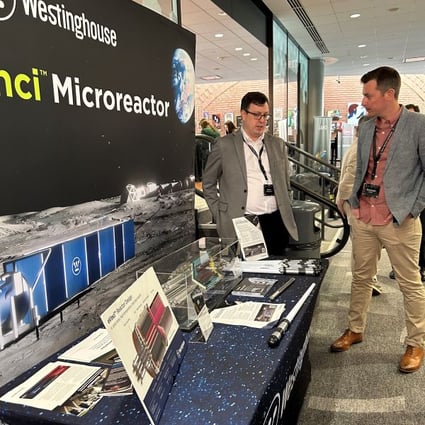 Over the last 14 months, our AstroVinci team has worked to complete the conceptual design of a fission surface power (FSP) for NASA. Designed to run for up to 10 years, this fission power system can sustain long-term missions while operating reliably through severe lunar conditions. Additionally, its fission power system can size up or down to address the end use function or mission specific to its life extent.
Over the last 14 months, our AstroVinci team has worked to complete the conceptual design of a fission surface power (FSP) for NASA. Designed to run for up to 10 years, this fission power system can sustain long-term missions while operating reliably through severe lunar conditions. Additionally, its fission power system can size up or down to address the end use function or mission specific to its life extent.
“AstroVinci enables Nuclear Electric Propulsion (NEP), which has a significant increase in both fuel efficiency (specific impulse) and maneuverability beyond current chemical technologies. This will enable everything from transporting humans to Mars, sample returns for deep space, and even powering in-situ resource utilization, such as hydrogen and oxygen generation, on the lunar surface,” said Krish. “AstroVinci will lead the charge and safely enable deep space exploration.”
With the advanced features of the eVinci microreactor, our AstroVinci incorporates a heat pipe reactor with a matrixed core design consisting of mixed controls and power conversion. Supporting power outputs from 10kWe to 2Mwe, the AstroVinci can easily adjust for space transport and deployment by addressing the power conditions of satellite or lunar surface applications.
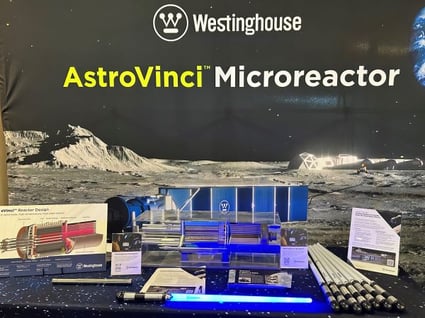 As we look toward the future of AstroVinci, we are more excited than ever to take nuclear beyond just Earth. With nuclear, we can help to build sustainable habitats on Mars, explore the solar system and provide additional energy security for the U.S.
As we look toward the future of AstroVinci, we are more excited than ever to take nuclear beyond just Earth. With nuclear, we can help to build sustainable habitats on Mars, explore the solar system and provide additional energy security for the U.S.
“AstroVinci’s impact on humanity allows us to start a meaningful journey into space,” said Ryan.
Although our team has wrapped up at the Lunar Surface Innovation Consortium, we’re preparing for many more exciting milestones for AstroVinci! Join us as we help provide the energy security necessary for humans to thrive on the Moon and continue exploring our solar system.
Backed by over 130 years of Westinghouse nuclear power design and operation experience, AstroVinci is a key energy partner of choice, helping to position the U.S. as the global leader in space exploration, science, and technology innovation.
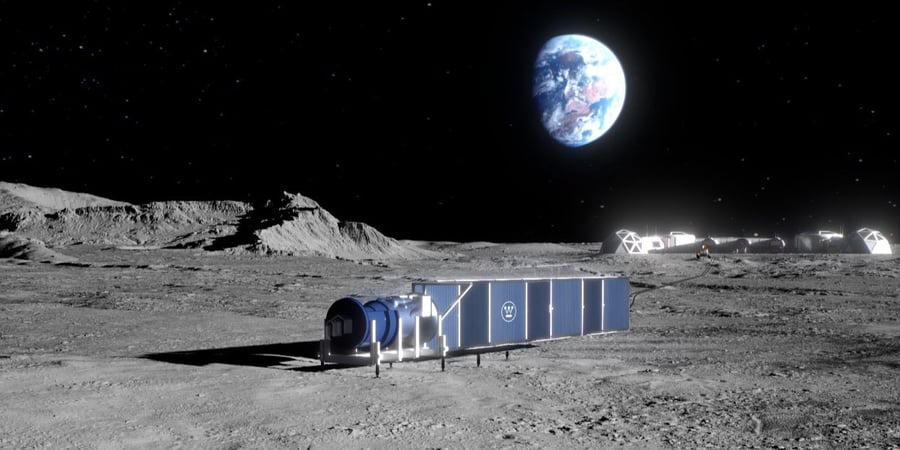
To learn more about the eVinci Space Microreactor technical capabilities, visit our new AstroVinci webpage: https://www.westinghousenuclear.com/energy-systems/astrovinci-microreactor/


